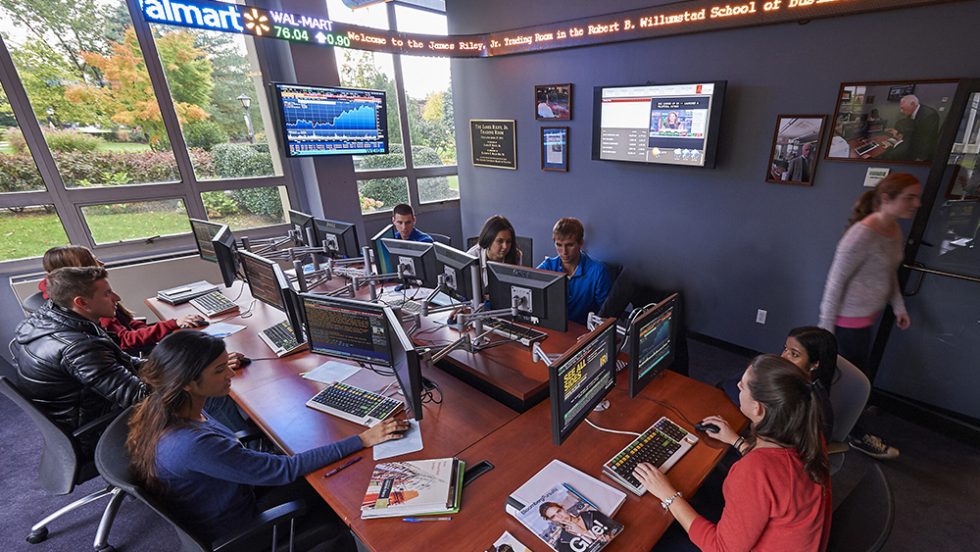
With our James Riley, Jr. Trading Room closed since last March, the finance course that allows business students to invest a portion of the University's endowment has gone virtual. Our students continued learning how to turn a profit during a volatile period.
Adelphi business students are hitting the virtual trading floor in a hands-on finance course that allows them to invest real, dedicated University funds in the financial markets.
In Spring 2020, Adelphi’s Student Investment Fund (SIF) course, which usually convenes on campus in Adelphi’s James Riley, Jr. Trading Room, pivoted online due to the pandemic, leaving students to navigate an unpredictable market remotely. Despite the challenges of taking the course online, students said they acquired valuable real-world investing skills from experts in the field and made gains for the portfolio, which is part of the University’s endowment. As of late Fall 2020, the fund was valued at about $460,000, up from $350,000 in 2018, as markets have universally gone higher over the past couple of years.
According to Robert Goldberg, clinical associate professor of finance and economics, the SIF has continued to run extremely well during the pandemic, with 100 percent participation via Zoom. “I suspect the students find the subject matter engaging, and they take true ownership of the course,” said Goldberg, who has overseen the course since it started in 2008 with an initial donation from James Riley Jr.
Amanpreet Singh, a senior majoring in finance, was one of those students who took the course this fall. “The Student Investment Fund isn’t a traditional course; it is structured in a way to prepare us for the real world,” he said. “The difference with this course is that SIF provides hands-on management of a real investment fund and all the tools you need for investing in the future.”
Investing Remotely, Learning from Experts
In place of Adelphi’s on-campus trading room, Goldberg gave students remote access to Bloomberg terminals, which run on software that brings together real-time data on every market, breaking news, in-depth research, powerful analytics and more.
“Just being able to learn how to utilize this software was fascinating enough, but we were also able to use the terminals to assist us in our research and analysis,” Singh said.
Students make investment decisions for the SIF as a whole. One of Goldberg’s graduate assistants, Patryk Czyzo ’20, who was a member of the Spring 2020 course, assisted students in making their choices this fall.
“The students decide on asset allocation [stocks and bonds], sector allocation [geographical locations, commodities and specific bond funds], and stock selection,” Czyzo said. “The class doesn’t sell investments just to realize profits; a solid argument must be made to make any change in strategy. The course has helped us with this, giving us a much greater grasp on analyzing financial developments.”
In addition to access to the Bloomberg terminals throughout the semester, students get a chance to learn from finance professionals from around the world via Zoom.
“Going online has allowed us to have many more guests during the three presentations each semester, as it is much easier to log in to Zoom than to come out to campus,” Goldberg said. “During our last presentation, we had several prominent alumni and donors join us, as well as a few more recent graduates, including one who joined us from her home in Bulgaria.”
Bloomberg Terminals for Real-World Experience
Goldberg said his students have done well navigating the market. “They have made sound investment decisions based on current events and learned valuable lessons about volatility and the benefits of diversification,” he said.
According to Czyzo, the Fall 2020 class realized gains even after deciding to switch the portfolio from 60/40 to a more conservative stock-bond allocation of 53/47. “They also made changes to our Asia exposure and added a new company [Orsted] to the portfolio,” he added. “With the market climbing, almost all components of the portfolio have seen gains.”
In addition to gains made as a class, individual students profited as well.
“While the class was in session, I used the Bloomberg Terminals to my advantage,” Singh said. “I researched and analyzed potential investments for myself, and was able to come to a decision on my own. This year has been a roller coaster, from the huge dip back in March to all-time highs, but I have made gains.”
Looking back on the impact of the course, Singh said he wishes he had taken it sooner, calling it a great learning experience that has prepared him to invest well before he lands a job in the finance world.
“There is nothing stopping us from investing at an early age,” he said. “That is why this course is phenomenal—because we don’t need to wait to get a job and to put our skills to use. We can make use of what we learn in this course right away and begin our future of investing. With a professor as experienced, knowledgeable and well-informed as Goldberg, it would be a shame if students didn’t take all that he has to offer.”
The Student Investment Fund course will be offered again in Spring 2021.